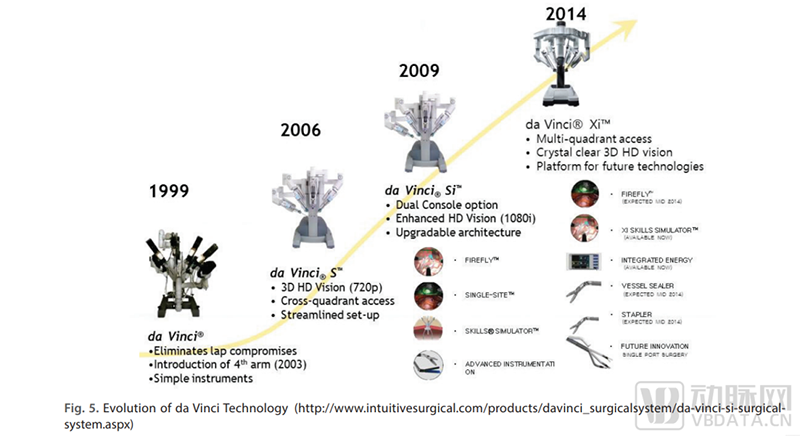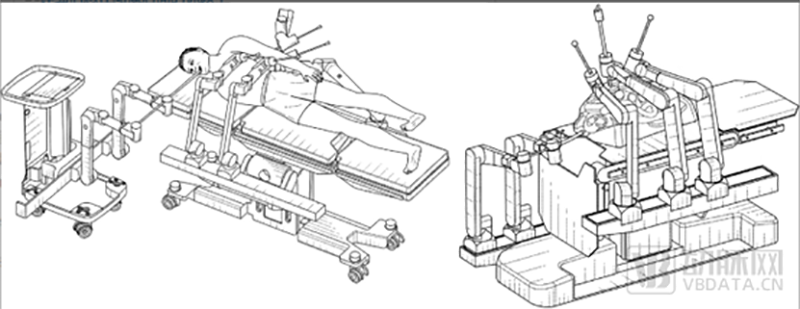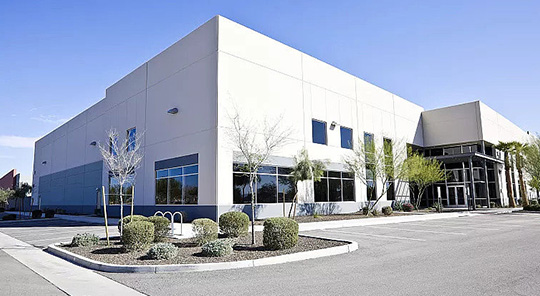
Since obtaining FDA approval for market launch in 2000, the invasive surgical da Vinci robot has been the leader in the field of surgical robots. Previously, companies such as CMR, Medtronic, and Titan medical joined, but none of them shook the dominant position of intuitive surgery.
However, in recent years, Da Vinci surgical robots have encountered crises, and due to the impact of the epidemic, Intuitive Surgical has experienced a decline in revenue growth. Gary Guthart, CEO of Intuitive Surgery, announced that he will make significant research and development investments in 2023, investing in clinical trials, expanding new categories of surgical robots, and operating new systems. The annual R&D expenses of Intuitive Surgical in 2022 were 879 million US dollars, a 31% increase from 2021. This means that in the future, Intuitive Surgical will invest more huge funds to innovate surgical robots.
In addition to facing weak growth, the surgical robot industry is also welcoming more strong players. Johnson&Johnson's natural canal surgical robot has shown strong performance, and a new surgical robot platform is poised to take off. At the same time, in the primary market, the market previously dominated by laparoscopic surgical robots is also undergoing changes, with microsurgical robots, soft tissue surgical robots, and natural cavity surgical robots becoming the main players in refreshing large-scale financing.
What is the development direction of the next generation of surgical robots, and how will intuitive surgery improve the long-standing da Vinci surgical robot system; Does the new type of surgical robot have the opportunity to become a major single product market for laparoscopic surgical robots. The arterial network has been sorted out.
How do elephants turn around and how do da Vinci surgical robots evolve?
The da Vinci surgical robot represents the pinnacle of medical technology, but it is actually a product of the last century.
In 1998, the second generation surgical robot system, Zeus System, was born. The characteristic of Zeus System is that the robotic arm integrates a surgical arm and an endoscopic arm. Compared to robotic assisted surgery, the advantage of the Zeus system is that doctors can perform laparoscopic surgery while sitting. The da Vinci surgical robot was successfully developed by Intuitive Surgical in 1999, and the Zeus and da Vinci surgical robots were integrated into one enterprise after a long patent war.
In the 1920s, Zeus surgical robots and da Vinci surgical robots were integrated into one enterprise after a long patent war, and the design of a robotic arm, console, and cart became the model for laparoscopic surgical robots in the next two decades.
In 2016, with the expiration of the Zeus surgical robot patent, surgical robots such as the UK CMR surgical and Medtronic Hugo gradually entered the market. The difference between this type of laparoscopic surgical robot and the da Vinci surgical robot is that it adopts a split design, with each trolley equipped with a separate mechanical arm.
From the evolution of da Vinci surgical robots, although today's da Vinci surgical robots have not undergone revolutionary changes compared to twenty years ago, Intuitive Surgical has actually undergone three innovations. The direction of these innovations has also become the main direction for the improvement of da Vinci's surgical robots.

The first generation of da Vinci surgical robots was launched in 1999, with four robotic arms. Compared to the first generation surgical robots, the improvement of the second generation da Vinci surgical robot launched in 2006 lies in its 3D high-definition vision, which is mainly reflected in improving the quality of intraoperative vision.
In 2009, Intuitive Surgical released the third-generation surgical robot system, which features dual consoles and is overall more compact and efficient; The third-generation da Vinci surgical robot entered the Chinese market in 2011.
The da Vinci Xi system (fourth generation) was released in 2014, and the fourth generation product entered the Chinese market in 2018. Compared to the third-generation da Vinci surgical robot, the da Vinci Xi system has improved imaging and flexibility. By using a suspended installation and mobile platform, it can meet the needs of surgical machinery to reach the surgical area in all directions, and the surgical arm is smaller and thinner than before.
In 2014, the da Vinci surgical robot introduced excellent real-time 3D images with natural depth perception through improvements. The significance of this technology lies in the fact that in laparoscopic surgery, doctors usually see two-dimensional images, but must think in a three-dimensional manner. 3D images can restore the three-dimensional surgical field in real vision, which is beneficial for identifying the lesion site, performing precise resection and reconstruction, and enabling surgeons to have good hand eye coordination skills during operations, significantly improving surgical efficiency.
The innovation direction of Da Vinci surgical robots also includes the innovation of minimally invasive surgical instruments. Although invasive surgical is a surgical robot company, it has always been consistent with leading minimally invasive surgical instrument companies such as Medtronic and Johnson&Johnson in the research and development of minimally invasive surgical instruments. Taking staplers as an example, Intuitive staplers, like Medtronic's intelligent stapler products, can also reduce damage to soft tissues through intelligent tissue thickness recognition.
In China, in terms of installation volume, the current installation of Da Vinci surgical systems is mainly third-generation products, with only a small number of fourth generation Xi products installed domestically. Domestic doctors are more proficient in operating third-generation systems.
In 2018, da Vinci Surgical Robotics also launched a revolutionary single hole surgical robot, which was approved by the FDA ® The system (single hole) can be used for adult single hole urological surgery, but this product has not yet entered China. Da Vinci SP uses an 8.5mm pre bending instrument. However, the Da Vinci single hole surgical robot still has not solved the "chopstick effect" of small operating space and interference with surgical instruments in single hole surgery, and the current surgical indications are relatively narrow.
From the above improvements, it can be seen that the improvement directions of the da Vinci surgical robot mainly include three aspects: improving image quality, improving operational accuracy, and expanding indications. This is also the direction for continuous improvement of da Vinci's surgical robots.
In terms of improving image quality, a major innovation of invasive surgery in recent years is the use of fluorescence imaging technology, which also provides doctors with images that cannot be seen by the naked eye during surgery.
In 2019, da Vinci launched the Firefly near-infrared fluorescence feature based on years of optical and imaging technology. The working spectrum of the fluorescence imaging system is in the range of 400-900nm. In addition to providing images of the surface layer of human tissue, it can also achieve fluorescence imaging of tissues below the surface layer (such as gallbladder ducts, lymphatic vessels, and blood vessels), playing a crucial role in precise positioning during surgery and reducing surgical risks. At present, this technology is also widely used in endoscopes.
Intuitive is continuing to explore fluorescence imaging systems by exploring fluorescent agents that can target key anatomical structures or abnormal tissues (such as ureters or prostate cancer). The Intuitive team hopes to help surgeons improve surgical outcomes by reducing damage to important structures and providing enhanced visualization effects to help surgeons perform complex surgeries more reliably.
The second core issue is to improve tactile feedback. There are still many problems that need to be solved in the da Vinci robot surgical system. The most obvious issue is the lack of tactile feedback, as the doctor's initial knotting is prone to breakage and tissue damage during gripping, requiring continuous learning to compensate through tactile experience and visual feedback. The advancement of sensor technology and artificial intelligence is improving the accuracy, grip, feedback, and autonomy of robotic surgical systems.
In terms of clinical application, the focus of Da Vinci's surgical robots is to expand indications, especially single hole surgical robots. In the world, the most widely used field of robot surgery is urology, especially in prostatectomy and partial nephrectomy. There are still many departments where robots have not yet penetrated, such as otolaryngology, which have become the focus of Da Vinci's surgical robot development. Currently, in 2019, the FDA approved the da Vinci SP surgical system for oral, ear, nose, and throat surgery in adults, limited to T1 and T2 benign and malignant tumors.
Other areas for improvement include improving the training methods for surgeons, changing the traditional teaching model for surgeons, and reducing the learning costs for doctors, especially in dealing with complex surgeries.
Overall, the improvement direction of Intuitive is mainly to utilize advanced hardware, software, and digital intelligence to enhance the senses of surgeons.
The strong enter the game, how can Johnson rewrite surgical robots
In the past, the surgical robot market was defined by invasive surgery, but with the expiration of a batch of patents for da Vinci robots. More strong participants are emerging in the field of surgical robots, and Medtronic and Johnson&Johnson are expected to take a share of the expanding surgical robot market.
Johnson&Johnson's Monarch leads the expansion of indications in the natural cavity surgical robot track, where both invasive surgical and Johnson&Johnson have product layouts. It is currently approved for use in lung and urinary surgery. Currently, Monarch has completed the diagnosis and treatment of over 20000 cases of lung cancer. Monarch's next key indication is kidney stones, and the first assisted kidney stone surgery has been completed.
In the field of orthopedic surgical robots, Johnson&Johnson has also expanded to the orthopedic field through the VELYS platform. VELYS is used in knee replacement surgery to improve the accuracy of bone cutting and has been approved by the FDA.
In addition to Monarch and the orthopedic digital system VELYS, Johnson&Johnson also has a more promising soft tissue surgical robot product, Ottava. According to existing published data, Johnson&Johnson's soft tissue surgical robot Ottava has significant differences from the da Vinci surgical robot.
The Ottava soft tissue surgical robot has six robotic arms, which are integrated into the operating table to reduce footprint. But it is currently unclear how to avoid mutual interference between instruments if six robotic arms are used simultaneously.
The advantage of the Ottava surgical platform lies in its ability to integrate with the Johnson Ethion platform, which is a global leader in energy surgical equipment and will have a greater advantage in improving surgical instrument performance in the future.
Another major advantage of Ottava is integration, as various surgical robots worldwide are independent products. For example, for laparoscopic robots and vascular intervention robots, Ottava is expected to become a platform that can simultaneously integrate vascular intervention robots and laparoscopic robots.
The research and launch progress of Ottava has been affected by the epidemic, and as the epidemic gradually normalizes, Johnson&Johnson will add more products in the field of surgical robots.
Compared to the behemoth of da Vinci surgical robots, from the perspective of Johnson&Johnson Ottava's research and development direction, surgical robots are evolving towards modularity.

Ottava Design Drawing
New direction: Microsurgical robots becoming a new track
The competition among giants in the surgical robot market is fierce, but there are also track giants that have not yet entered. Although the da Vinci surgical robot is proficient in the field of laparoscopy, it has not yet been widely used in reconstructive, lymphatic, and eye surgeries. These tracks that require more precise surgical robot operations have become fertile ground for the growth of innovative enterprises.
Taking microsurgical robots as an example, traditional microsurgical procedures rely on optics and precision surgical instruments to complete the surgery. The surgical department needs to be magnified 5 to 40 times under optical instruments in order to perform the surgery manually. Microsurgery usually requires the anastomosis of 0.3-0.8mm lymphatic vessels or nerves, which has a large unmet demand in multiple departments such as otolaryngology, lymphatic surgery, neurosurgery, and plastic surgery.
Taking ophthalmic surgery as an example, in the field of ophthalmic surgery, the movement of instruments around the puncture point of the sclera can easily cause tearing of the incision tissue for patients, affecting postoperative healing. Moreover, the precision required for ophthalmic surgery is extremely high, with an ideal precision of 10 microns. However, in ophthalmic surgery, there is a natural tremor of about 100 microns in the human hand, which can easily cause retinal damage and affect vision recovery.
This market, which has been overlooked by giants, is experiencing breakthroughs as multiple innovative companies begin to develop innovative products. This includes the Symani system developed by Italian company Medical Micro instruments and the MUSA system developed by Dutch company Microsure.
The principle of Microsure's microsurgical robot is to filter tremors by reducing motion, maintain hand stability during microsurgical procedures, and enhance the ability of doctors to repair anatomical structures during microsurgical procedures. The application scenarios of MUSA include lymphatic vein anastomosis, distal nerve repair, vascularized tissue transplantation, and many other complex microsurgical procedures. MUSA has been proven to be safe and effective in suturing blood vessels to reduce lymph node swelling. Microsure has currently secured a financing of 2.7 million euros.
Symani aims to enhance the natural flexibility and range of motion of surgeons, enabling them to move beyond the range of human hands. For example, suturing veins, arteries, nerves, and lymphatic vessels with a diameter as small as 0.3 millimeters. Medical Micro instruments has also received a financing of $27 million.
At present, two domestic companies, Angtai Jingwei and Dishi Medical, have also obtained financing in this field. Angtai Jingwei has multiple products, including general-purpose microsurgical robots, ophthalmic surgical robots, and gastroscopy robots. Dishi Medical takes ophthalmic surgery as its entry point and delves into the field of microsurgery. The Dishi Medical Ophthalmic Surgery Robot has completed the type inspection.
The field of surgical robots has always been the pinnacle of medical technology innovation. After 20 years of development, surgical robots have reached new heights in both technology and clinical awareness. This also means that the market has the opportunity to brew new changes, and we look forward to more transformative innovations in the field of surgical robots. picture
Reference materials:
Progress in Pediatric Surgery | Current Status and Prospects of Pediatric da Vinci Robot Surgery -- Tang Shaotao
Past, present and future of surgical robotics——trend in urology & men health
Disclaimer: We respect originality, and the copyright of the cover and images in the text belongs to the original author. If there is any infringement of your rights, please contact us promptly to delete it












